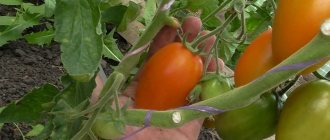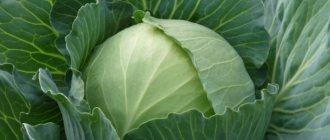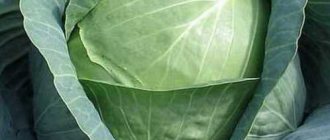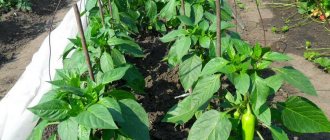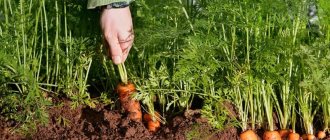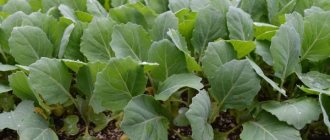Description of the variety
The characteristics of Kharkov cabbage make it possible to classify it as a late-ripening variety. Technical ripeness of the heads occurs 150–160 days after emergence. It was bred in Ukraine by crossing the best varieties Amager 611 and Dauerweiss.
Kharkovskaya tolerates drought and high air temperatures well, which is why it has gained wide popularity throughout Europe and Asia. Heads of cabbage of universal use, flat-round shape, light green color. The cabbage rosette reaches 110 cm in diameter. The weight of the head ranges from 1.9 to 3.5 kg. The yield per square meter is 10–11 kg.
Young plants of Kharkovskaya during the growth period can withstand temperatures dropping to -2 °C and rising to +40 °C. Lack of moisture does not affect taste and product quality. Cabbage heads do not crack even if they remain in the garden in their ripened form longer than expected.
Consumer qualities of the vegetable
Kharkov winter cabbage forms dense, not very large, but heavy heads of cabbage with a diameter of about 30-40 cm. They have a round, sometimes slightly flattened shape. The average weight of a vegetable at technical ripeness reaches 4 kg.
The covering leaves adhere tightly to the head of cabbage. The plugs are completely protected from frost or hot weather. The edges of the covering leaves may rise slightly. The color of this shell is rich green, with a bluish waxy coating.
The edible part of the vegetable is contained under the covering leaves. When cut, Kharkov winter cabbage is white in color, turning into a slightly creamy shade in the center of the fork. The part adjacent to the covering leaves may be greenish. The stalk is quite large and reaches 15-20 cm, but not too thick. Inside the head of cabbage there are practically no hard veins or leaf bases. About 93% of the vegetable can be used for food; little waste is generated.
The characteristics especially highlight the sweet taste and high sugar content of the vegetable. The cabbage leaves are tender and crisp, contain a lot of juice and have a strong, characteristic aroma. Cabbage contains a high content of vitamin C, dietary fiber (fiber), and a rich microelement composition (potassium, sulfur, zinc).
The main purpose of Kharkov winter wine is fresh storage and fermentation. But you can also make very tasty salads from it. For fresh consumption, it is better to choose the upper part of the head: the most tender parts of the leaves are concentrated there. They can be finely chopped and cut into pieces, depending on the salad or appetizer recipe. The rougher bottom part is suitable for hot dishes.
You can make excellent rooks and casseroles from cabbage, cook cabbage soup or borscht, stew it and include it in the filling for pies. Whole leaves will make good cabbage rolls, since the leaf has practically no hard petiole.
The variety is best suited for pickling. The high sugar content promotes the rapid development of fermentation processes, and a large amount of juice will not allow the cabbage to spoil during storage. Sauerkraut can be preserved until the next harvest, covering all the family’s vegetable needs.
In addition to the classic cold method, cabbage can be preserved according to other recipes, by salting and pickling chopped or shredded heads of cabbage. Cabbage is used to make a variety of winter salads with the addition of other vegetables and is included in canned snacks. Fresh heads of cabbage are stored in a cold cellar for 6-7 months and can be consumed throughout the winter.
Growing
The description of the variety states that Kharkov cabbage can be grown in two ways: seedlings or non-seedlings. The plant is a sun-loving plant, so it is advisable to have well-lit beds for it. The seedless method involves sowing seeds directly into the ground. This is done at the end of April or at the beginning of May. Sowing is done to a depth of no more than 2 cm. Dry soil is pre-moistened one day before the start of work.
The distance between the rows of Kharkovskaya is about half a meter. As soon as seedlings begin to appear, the crops are thinned out and only the strongest specimens are left.
When growing cabbage seedlings, seedlings are planted in open ground a couple of months after sowing. The distance between the holes is left at 40 cm.
See also
How to fight aphids on cabbage using traditional methods and how to treat them at homeRead
Kharkov cabbage
Late winter Kharkov cabbage - the variety was bred by Ukrainian breeders by crossing two varieties Dauerweiss and Amager 611. At first it was planted only in Ukraine, in Kharkov. Gardeners appreciated the new variety and its positive qualities and began to grow it in Europe and Asia.
Characteristics and description of the variety
Tolerates adverse weather conditions very well. Lack of moisture does not reduce the yield. Tolerates heat up to +40°C, frost down to -3°C. You can harvest until late autumn. Resistant to cabbage viral diseases.
Kharkov cabbage is good fresh and pickled, can be stored for a long time, and does not spoil during transportation. Suitable for salads, pickling, pickling, winter preparations.
| Purpose of the variety | Universal |
| Head of cabbage (appearance) | Round-flat, dense, does not crack |
| Color | Green |
| Size | 85–115 cm |
| Fork weight | 2–3.6 kg |
| Ripening time | 155–160 days |
| Productivity per square meter | 11–12 kg |
Important! Cabbage can be stored in a dark cellar for up to 6 months. To extend this shelf life, the heads of cabbage are not cut, but pulled out and hung by the stalk, head down.
Agrotechnics of cultivation
Kharkov late cabbage is grown in two ways:
- By sowing seeds in the ground, that is, in a seedless manner.
- Seedlings.
Advantages of the seedless method:
- Seedlings are not transplanted to a new place; plants do not have to painfully get used to open ground.
- Plants sown with seeds take root faster and the fruits ripen faster.
- Heads of cabbage reach full maturity 2–3 weeks earlier.
Cabbage Kharkov seedlings
A place for sowing cabbage should be allocated in the southern sunny area of the garden plot. Cabbage should be grown in one place after 4 years; it grows well after onions, potatoes, cucumbers and legumes. Depending on the weather conditions of a given region, seeds are planted in the ground in late April - early May.
Dry soil is moistened a day before sowing. Seeds are planted in rows, the distance between which is 65–75 cm. The sowing depth is 1.5–2 cm. It is not recommended to place seeds closer to the surface of the ground - this will affect their germination. When the seeds sprout, small and extra seedlings are discarded, leaving only the strongest plants.
Caring for seedlings: watering, fertilizing, loosening.
Seedling method of growing late cabbage
To grow seedlings, you need to prepare soil, dishes, and seeds. The soil can be prepared in the fall and stored in winter until spring. It is recommended to buy ready-made soil or make a mixture yourself from peat (75%), turf soil and sand. It is recommended to disinfect this mixture a week before sowing.
Seed preparation
Calibration is needed in order to select the largest and highest quality seeds. They need to be soaked in a 3% salt solution. The light ones will float, the heavy ones will sink to the bottom. The water with light seeds is drained. Large ones are washed and dried. For disinfection, soak for 25 minutes in a 1% solution of potassium permanganate.
The seeds are soaked for a day in water (+15...+20°C), placed in a warm place, after 4 hours the water is changed and the seeds are mixed. After swelling, the grains are placed on a damp cloth and hardened for a day in the refrigerator at a temperature of +1...+3 degrees.
Preparing containers for seedlings
For sowing and growing seedlings at home, cups, pots, boxes, and cassettes are used. There should be holes in the bottoms of the dishes to prevent water from stagnating.
To disinfect containers: dissolve 5 g of potassium permanganate in a bucket of hot water; use this solution to treat seedling containers and all planting tools.
Sowing and care
Seeds are planted 45–50 days before transplanting into open ground. For full growth, cabbage seedlings need a sunny place (+18...+20 degrees).
Seedling care is standard: watering, fertilizing, weeding, loosening. The seedlings need intensive watering for the first week. After transplanting into open ground, water daily for the first week, later 1–2 times a week.
It is important to know! Nitrogen-containing fertilizers negatively affect the quality of heads of cabbage. Nitrogen loosens the leaves, and the cabbage begins to rot in the first days of storage. Fertilizers with phosphorus and potassium extend shelf life.
If necessary, remove weeds and loosen the soil. Kharkov cabbage grows well if it is fed on time and correctly. Fertilizers are applied 2-3 times during the season. It is best to fertilize during intensive leaf growth and head formation. Mineral fertilizers are used for feeding.
Pests and diseases
Late Kharkov cabbage persistently resists the main diseases of this vegetable. She is not afraid of mucous bacteriosis and necrosis. Resistant to Fusarium wilt at an early age. Cabbage is rarely affected by rot. No aphids or flea beetles appear on the leaves.
If grown improperly on acidic and heavy soils, it can be affected by clubroot. For prevention, you need to choose the right site and soil for planting.
Pests: slugs, caterpillars - can damage the plant.
Snails and slugs
To combat slugs, you need to take a liter jar of wood ash, 2 tablespoons of table salt, 2 tablespoons of ground black pepper, 2 tablespoons of mustard powder, mix and sprinkle on the cabbage beds.
Harvesting rules
Kharkov winter cabbage is characterized by high yield and long shelf life. When the cabbage is ripe, it is very important to properly harvest the crop and send it for “wintering” - storage.
Kharkov cabbage tolerates heat and cold well, so there is no need to rush into harvesting. Until late autumn, the heads of cabbage grow and do not crack. They are not afraid of light frosts down to -6°C. But exposure to such low temperatures should not be prolonged, otherwise the heads of cabbage will rot during storage.
You can’t leave cut heads of cabbage even at a frost of -1 degree; frozen leaves and stalks on the cuts will begin to rot and ruin the entire harvest.
You cannot harvest cabbage immediately after frost. The heads of cabbage should thaw at the root within 5 days. If you cut off the frozen heads of cabbage right away, they will begin to rot within a month and black leaves will appear.
The collected heads of cabbage cannot be immediately put into the cellar for storage, even if the harvesting took place on a sunny, warm day. Before storage, cabbage should be dried for at least 5 hours under a canopy, but not in the sun. In direct sunlight, cabbage withers.
The timing of harvesting varies from region to region and depends on weather conditions.
After harvesting, it is necessary to sort and remove cabbage debris. Eat small non-standard heads of cabbage first, use the leaves for livestock feed, and put the remaining green waste in compost.
Advantages and disadvantages of the variety in comparison with other varieties
Kharkov winter cabbage differs from other varieties in the compactness of its leaf rosette. Its leaves are of medium size, almost without roots, raised above the surface of the bed, so the plant occupies a small area compared to other varieties. The Kharkov winter one can be planted more densely than the Moscow late one.
Kharkov late-ripening forms heads of cabbage at the end of summer, but can remain in the garden until frost, without suffering from the cold and without cracking of the heads of cabbage. The taste of cabbage will only improve during this time.
The first autumn frosts will not damage the crop. The cabbage only becomes sweeter and then sauerkraut is especially tasty.
The covering leaves fit tightly to the head of cabbage and protect the edible part. When cut, the color of the head of cabbage is white, the stalk is large, but not thick. There are no hard veins inside the fork. There is little waste.
Cabbage is very healthy and tasty
93% of the edible head of cabbage is used for food. The leaves are juicy, sweet, aromatic. Cabbage contains many useful substances: vitamin C, fiber, microelements - potassium, sulfur, zinc.
The main use of Kharkov cabbage: storage and pickling. But even fresh, you can prepare many dishes from it: fresh salads, cabbage soup, borscht, cabbage rolls, pie fillings.
Housewives most like pickled Kharkov winter cabbage in the cold classic way, because it is juicy and survives the winter without changing its taste. There are also hot ways to prepare cabbage for the winter. If you cook cabbage along with other vegetables and roll them up for the winter, the whole family will enjoy delicious salads and snacks until spring.
The buyer can purchase seeds at any store to grow Kharkov late winter cabbage on his plot. Sometimes gardeners grow their own cabbage seeds if they like the variety.
Features of care
Reviews from experienced gardeners indicate that after planting in open ground, Kharkov cabbage should be watered daily for the first week. As soon as the plants take root, irrigate them 1-2 times a week. This variety responds favorably to fertilizing. It is worth applying them 2-3 times per season. The best time for these activities is considered to be the period of active growth and head laying. Mineral fertilizers are mainly used.
With proper care, the Kharkov winter cabbage variety can please the gardener with a truly royal harvest. Its description recommends systematically loosening the soil and removing weeds. The first weeding is carried out after the seedlings take root in the garden bed, and further weeding is carried out as needed. To prevent the growth of weeds and facilitate the maintenance process, they resort to mulching the soil.
Transplanting seedlings to a permanent place
The most important step in growing cabbage is transplanting young seedlings into the garden bed. The quality of rooting and fruiting of cabbage depends on the correctness and consistency of all operations during this period.
Transplant timing
Depending on the sowing date, Kharkov winter planting is carried out from the middle to the end of May. By this point, stable warm weather should arrive, and the seedlings should produce at least 5 leaves.
Selecting a location
The best soil for growing vegetables is considered to be substrates with high or medium moisture capacity. Areas with well-fertilized loamy soils with a neutral pH are ideal for this. In their absence, the soil must be prepared; for this, 3 buckets of sand, 1 bucket of humus, 1 kg of dolomite flour or chalk should be added per 1 m² of land.
The area of the beds should be located on a hill or plain. It is not recommended to plant cabbage in lowlands - this will lead to increased humidity in the beds and the appearance of putrefactive lesions. Also, the plant does not tolerate prolonged exposure to direct sunlight, so it is best to place the beds in partial shade. Ideally suited for this will be proximity to tall vegetation and garden buildings.
Planting pattern and depth
Cabbage seedlings are planted in rows, with a row spacing of 60–70 cm and a distance between neighboring plants in a row of about 35–40 cm. The planting depth should be within 5–10 cm.
Cabbage planting scheme. If the vegetable is grown in an open and well-lit area, it is necessary to plant tall crops that create moderate shading every 5–10 rows. Corn or sunflower are best suited for this.
Advantages and disadvantages
Kharkov cabbage has a lot of advantages over its competitors, which were appreciated by summer residents and farmers. These include:
- high productivity;
- suitability for long-distance transportation without loss of commercial qualities;
- tolerates lack of moisture in the area;
- crack resistance;
- large head of cabbage;
- increased resistance to pests and diseases;
- tolerates hot weather well;
- the possibility of late harvesting without losing its quality;
- preservation of the crop in storage for up to six months;
- universal use of heads of cabbage.
No significant shortcomings that would be worth focusing on were identified in Kharkov cabbage.
Pests and diseases
Kharkovskaya has demonstrated excellent resistance to major diseases. In particular, it is not afraid of mucous bacteriosis and necrosis. But slugs can significantly ruin the cabbage harvest. To combat them, it is recommended to take a liter jar of wood ash, 2 tbsp. l. table salt, 2 tbsp. l. ground black pepper, 2 tbsp. l. mustard powder. Mix everything thoroughly and scatter over the cabbage beds.
Harvest and storage
The harvest of Kharkov cabbage begins 150 days after emergence. To carry out the work, choose clear and dry weather, preferably before the onset of the first frost.
See also
How to properly plant cabbage in open groundRead
The harvested crop can be stored for up to six months, that is, almost until the cabbage ripens next season. During storage, it is not exposed to pests and is not affected by diseases. The taste quality is excellent throughout the entire period. The Kharkovskaya storage room should be dark and cool. This will ensure maximum safety.
Productivity
Cabbage of the Kharkovskaya winter variety is ready for cutting 150 - 160 days after emergence. The entire planting reaches maturity together. The harvest is well preserved in the garden until the first frost. Tolerates a decrease in temperature to -1-2o C, without losing taste and storage resistance. This variety is valued by farmers who grow vegetables for sale for its excellent condition after long transportation.
Cabbage can be stored in a dark room protected from light for up to 6 months. The shelf life is extended by a method in which cabbage heads are not cut, but pulled out together with the stalks and hung upside down by the stalk. The variety is universally used: fresh salads, canning, pickling, preparing various dishes.
Cabbage is one of the most productive vegetables. At state variety trials, the variety showed yields of up to 80 t/ha, with a maximum of 108 t/ha. In terms of per hundred square meters it will be 1100 kg. Commercial output will be about 100%.
Cabbage Zimovka 1474 is unpretentious to growing conditions, and its seeds have good germination. But to achieve high yields, it is recommended to carry out preliminary preparation of planting material and soil on the site, as well as adhere to simple rules for growing seedlings and transplanting them into open ground.
It is recommended to purchase Zimovka 1474 cabbage seeds in specialized stores.
To prevent damage to plants by diseases and pests, as well as to accelerate the germination of planting material,
- select seeds of the same size and correct shape;
- soak the planting material in an aqueous solution of potassium permanganate for 15–20 minutes to disinfect, and then rinse it with clean water;
- To speed up the germination of seeds, you can place them in gauze and immerse them in hot water at a temperature of 50°C for 15 minutes. After this time, the gauze with planting material must be cooled in cool water;
- After completing all the above steps, the seeds need to be spread out on paper in one layer and dried at room temperature.
Growing seedlings
It takes about 50 days to grow strong cabbage seedlings Zimovka 1474, so it is recommended to start this process in early April. Seeds are planted in small containers or individual containers filled with a mixture of garden soil, humus, sand and wood ash (all ingredients are taken in equal proportions).
Important! 10–14 days before planting the seeds, the resulting soil mixture must be calcined in the oven for 20 minutes at a temperature of 200°C or poured with a hot aqueous solution of potassium permanganate for disinfection.
Step-by-step instructions for growing cabbage seedlings Wintering:
- Water the soil in the containers with water so that it is well moistened. Make indentations about 1 cm in size at a distance of 3-4 cm from each other.
- Place 1-2 cabbage seeds in each hole and cover them with soil. Gently level the surface of the earth with your hands.
- Cover the container with the planted seeds with film or glass. Place it in a well-lit place, periodically moistening the soil with warm water as it dries.
- Seedlings appear 5 days after planting. After this, the cover must be removed and the container with seedlings kept at a temperature of 10°C until the first green leaves appear.
- 7–10 days after seed germination, the seedlings are watered with a weak solution of potassium permanganate for disinfection and feeding with nutrients.
- If the seeds were sown in one large container, then 10–14 days after the emergence of seedlings, when they already have 4-5 leaves, the sprouts are planted in individual containers. In this case, the roots of the sprouts need to be shortened by a third of their length.
- After picking, the seedlings should be kept in a well-lit place with an air temperature of 14 ... 18 ° C;
- The duration of daylight for cabbage seedlings should be at least 12 hours a day. If necessary, use sources of artificial lighting.
- As the soil dries, moderately water the sprouts with warm water. After irrigation, surface loosening of the soil is carried out.
- As an additional feeding, you can sprinkle the leaves of the seedlings with wood ash powder.
- The container with seedlings should be kept in a well-ventilated place, but the sprouts should be protected from cold drafts so that the seedlings do not die.
In order for the cultivation of Zimovka 1474 cabbage to bring a generous harvest, you need to choose the right site.
The place for cabbage must meet the following requirements:
- good sun exposure;
- loamy or clayey soil composition;
- neutral soil acidity;
- lack of groundwater close to the surface of the earth;
- good predecessors for vegetables are legumes, potatoes, cucumbers and tomatoes;
- This crop cannot be planted for 3 years on an area where turnips, turnips or radishes were previously grown.
Did you know? The name “cabbage” comes from the ancient Greek word “kaputum” and literally translates as “head”.
Preparing the site for planting cabbage seedlings begins in the fall, after harvesting.
This procedure includes the following steps:
- thorough removal of all plant residues after harvesting in the fall;
- deep autumn digging of the earth with the addition of lime;
- adding humus in the spring (1 bucket per 1 m²) and re-digging the area;
- digging holes 2 weeks before planting seedlings.
In order for cabbage seedlings to take root well in open ground, they must become stronger by the time of transplantation. Each sprout should have 5-6 strong green leaves, and the height of the seedling should be at least 15 cm. Typically, plants reach these figures by the end of May or beginning of June, after which they are planted in a permanent place.
Instructions for transplanting cabbage seedlings Wintering:
- Seedlings should be placed on the plot according to a 35×60 cm pattern.
- Place 2 tbsp at the bottom of each well. l. superphosphate, 2 tbsp. wood ash and 1 tsp. urea.
- Lightly water the sprouts in individual containers with water to make it easier to remove them along with the earthen lump. Carefully remove the seedlings from the containers and place them in the prepared holes.
- Sprinkle the roots of the seedlings with soil and lightly compact its surface with your hands.
- Water the planted seedlings generously with warm water.
Heads of cabbage of this variety ripen in late September or early October. The fruits are frost-resistant, but before the onset of serious cold weather and the rainy season, it is recommended to remove them from the garden so that the vegetables do not begin to rot.
Important! Cabbage Zimovka 1474 can withstand frosts down to -6°C, maintaining its good taste and attractive presentation.
Basic rules for harvesting and storing wintering cabbage:
- heads of cabbage need to be dug up in dry weather so that the leaves are dry and do not rot;
- harvesting is carried out carefully so as not to damage the fruits;
- the head of cabbage is removed from the soil along with the root and cleared of the upper leaves;
- after digging, the cabbage must be removed from the sun and hung in the shade to dry;
- the room in which vegetables are dried must be well ventilated;
- fruits are stored in a darkened basement with good ventilation and an air temperature of about 0... 2°C;
- Only whole heads of cabbage without mechanical damage or rot are suitable for winter storage;
- In storage, vegetables can be placed on racks, hung from the ceiling, or placed in small containers, sprinkling each layer of fruit with chalk. The top of the container is covered with a layer of dry straw.
If you follow the recommendations listed above, Zimovka cabbage tolerates long-term winter storage well.
The taste of the vegetable does not deteriorate, so it is used for cooking:
- first courses (cabbage, borscht, soups);
- vegetable side dishes and stews;
- baking fillings;
- fresh salads;
- fermented snacks and pickles.
Cabbage variety Zimovka 1474 combines excellent taste, ease of cultivation and good keeping quality, and is therefore often chosen by gardeners for growing in large and small plots. Using the characteristics of the variety and the growing recommendations listed in this article, you can easily get a generous harvest of large heads of cabbage that will delight you with their rich taste throughout the winter.
Reviews from gardeners
Kharkovskaya has been cultivated in garden plots for quite some time. That is why experienced summer residents and farmers are happy to share their reviews about this variety.
Galina Stanislavovna, retired summer resident: “I’ve been growing Kharkov cabbage on my plot for more than 5 years. I bought it for the first time in the form of seedlings on the market and since then I have never changed this variety. Despite the fact that the conditions in my garden are not the best, I managed to harvest a decent harvest and provide the whole family with cabbage for the whole winter. The heads were stored in the basement until the early varieties began to ripen in the beds the following season.”
Inna Valentinovna, resident of the village: “My husband bought Kharkovskaya seeds in a store on the advice of the seller. Since then, of the later varieties, we prefer only this one. The heads can be used for preparing salads and pickling, as well as cabbage rolls and other culinary masterpieces. Cabbage is preserved just fine and is not difficult to care for. We are very pleased with our choice."
Anton Grigorievich, summer resident: “The Kharkovskaya variety is very good, only because of my inexperience I almost ruined the first plantings. I decided that cabbage loved water and tried my best to water it. As a result, the root system almost died, thanks to the neighbors who helped with advice. That year it was not possible to grow a rich harvest, although we were not left without cabbage. Later, I took into account my mistakes, and now Kharkovskaya shows excellent results in our area.”
